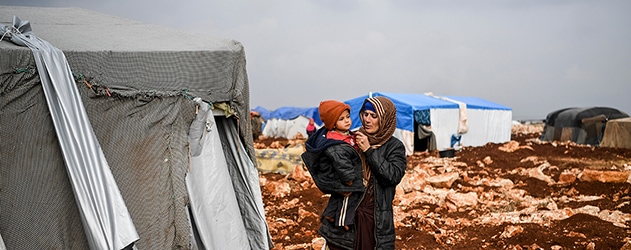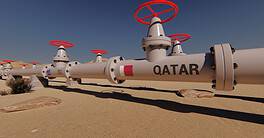Putting the war-ravaged country back together will cost $400 billion. With Assad still in power and US sanctions still in place, who will foot the bill—and reap the benefit?

At the beginning of the Syrian civil war eight years ago, the odds that President Bashar Al-Assad would survive the brewing conflict seemed absurdly low. Fast forward to 2019 and he is not only still in power, but the person most likely to preside over the country’s mammoth reconstruction effort, which by his own estimate may require as much as $400 billion in funding.
No wonder erstwhile archfoes from the Arab League are rushing to re-embrace Assad. In December, the UAE re-opened its embassy in Damascus and Sudan’s president, Omar al-Bashir, became the first Arab League leader to visit Syria in eight years. Step by step, Assad is returning from the brink to the Arab fold.
He’ll need a lot more friends. At the end of 2018, the London-based Syrian Observatory on Human Rights estimated up to 560,000 had lost their lives in the conflict since March 2011. Not only the country’s infrastructure, but millions of lives will have to be rebuilt. Furthermore, despite onerous sanctions, reconnecting Syria with global financial markets is also fundamental to the country’s economic rehabilitation. Getting it done will depend on Assad.
Who can afford to fund Syria’s rebuilding? It’s a poor country; this year’s budget is a modest $9 billion, with a little over $1 billion earmarked for reconstruction. Syria is also a complex geopolitical story. Given a total breakdown in the rule of law, and a regime likely to line its pockets and those of its supporters out of any reconstruction funds, rebuilding will test the nerve of even the most resilient investors.
Western governments, including the US and UK, have ruled out participating in Syria’s reconstruction while Assad remains in power, choosing instead to funnel money to NGOs. According to Joshua Landis, director of the Center for Middle East Studies at the University of Oklahoma, there is still a strong desire outside the region to see Assad pushed from office. “The Western international community is determined to keep Syria poor, in hopes of gaining leverage to use against Assad,” Landis says. “Western governments and UN agencies continue to propose a ‘political solution’ for Syria.”
Western governments standing pat leaves few countries that have the financial clout—and willingness—to underwrite the colossal costs of reconstruction. Some, like neighboring Lebanon, could benefit indirectly; the Lebanese port of Tripoli lies 19 miles by coastal road from the Syrian border and sidesteps the logistical and political challenge of using Israeli ports.
Doing the Unthinkable
Several members of the six-state Gulf Cooperation Council, notably Saudi Arabia and the United Arab Emirates, actively supported Syrian rebels who fought to overthrow Assad; but they are now actively seeking to re-engage. In January, Abu Dhabi hosted a high-level UAE-Syria private-sector forum, something that would have been unthinkable a few months ago. But the rapid U-turn is strategic; both Saudi Arabia and the UAE want to contain Iran’s regional ambitions. Tehran will be one of the early beneficiaries of any Syrian reconstruction efforts, despite the constraints that EU and US sanctions place on both Damascus and Tehran.
New land laws leave a lot of room for chicanery by the rich and seem designed to leverage private capital to rebuild by expropriating land from those too poor to rebuild.”— University of Oklahoma Professor Joshua Landis
The Gulf’s about-face limits Turkey’s bid for regional supremacy. Under President Recep Tayyip Erdoan, Turkey increasingly sees itself as the leader of the Sunni Muslim world, a claim that gained momentum in the aftermath of the murder of Washington Post columnist Jamal Khashoggi. It’s not out of the question that Saudi Arabia could revert to checkbook diplomacy in a bid to limit Turkey’s role in Syrian reconstruction.
And Syria has its own preferences. “For immediate reconstruction needs, the Assad government has said it will prioritize working with Russia and Iran, whose militaries have been critical for Syrian forces throughout the conflict; and with China, whose neutrality throughout the conflict Damascus welcomed,” says Emily Hawthorne, a MENA analyst at Stratfor, a US geopolitical intelligence firm, although she doubts whether even the Chinese have patience enough. “No one is willing to put in the kind of money needed for reconstructing Syria,” she says flatly. “The process will take decades.”
Still, Iranian Vice President Eshaq Jahangiri said in January that Iranian and Syrian banks would carry out transactions in local currencies as well as nondollar denominated transactions to facilitate trade and investment. Iran also plans to build a $413.59 million, 526-megawatt power plant at Latakia, and a gas pipeline from Baniyas to fuel it, both scheduled for completion in three years.
Among Assad’s prospective donors, China arguably has the deepest pockets. But a faltering domestic economy and criticism of President Xi Jinping’s flagship Belt and Road Initiative may make China a hesitant participant. Beijing’s usual model of aid is through loans with a requirement that Chinese firms carry out the construction, but it is unclear whether this would be a viable model in Syria. With potentially vast sums involved, China may not want to risk the reputational damage of riding to Assad’s rescue.
Any investment in Syria risks exposure to US, UN and EU sanctions. Washington has doubled down, warning international businesses to not invest in Syrian reconstruction at risk of the same treatment as the daughter of Huawei’s chief executive, recently held in Canada on charges of violating US sanctions against Iran. That could stifle many prospective investors’ reconstruction plans, particularly those supported by China, in wariness of further inflaming the US.
That leaves the EU with some latitude, however, particularly toward Teheran. In January, Brussels finally unveiled a special-purpose vehicle (SPV) to shield EU companies from US sanctions against trade with Iran. Dubbed Instex, or Instrument in Support of Trade Exchanges, the SPV is registered in France, led by Per Fischer, a German banker with experience in emerging markets, and currently restricted to trade in “essential goods,” meaning food and medical supplies. In effect, it is a state-owned trade intermediary. But it serves notice the EU will not be unflinchingly submissive to US foreign policy preferences.
The implications of the EU SPV for Iran’s role in rebuilding Syria are unclear. But given the pressure European countries still feel from the 6 million Syrian refugees—1 million of them on Europe’s shores—it is not beyond the scope of possibility that it could be used to fund Syria’s rebuilding.
Little Ground for Optimism
The Assad regime’s attitude toward its own population offers little ground for optimism that reconstruction will be carried in an organized or even legal manner. Indeed, the vast project looks intended to benefit insiders. The University of Oklahoma’s Landis notes that the government recently passed legislation that may allow it to seize land for new construction. “New land laws leave a lot of room for chicanery by the rich and seem designed to leverage private capital to rebuild by expropriating land from those too poor to rebuild,” he says.
“About one-third of housing stock and one-half of health and education facilities [have been] damaged or destroyed,” the World Bank reported in an update on Syria published last October. The country’s acutely impoverished citizens live in a dangerous neighborhood, and Iran’s near-certain involvement in reconstructing the country could pitch it directly against Israel. Tensions between Russia and Turkey make their respective roles unclear as well.
Meanwhile, in Damascus, Assad looks more secure than ever.



